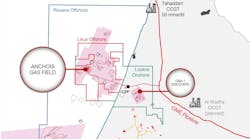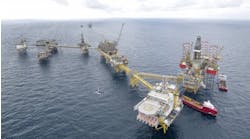Kristin costs surge
Statoil has warned of a steep rise in the final price of its Kristin development in the Norwegian Sea. Drilling and completion issues have pushed the overall price tag up from NKr1.4 billion to NKr20.8 billion. Contingencies have also been set aside for a further NKr500 million, due to concerns over future well performance.
Kristin’s reservoir is heavily faulted and deep-lying at over 4,500 m beneath the seabed. Conditions are among the toughest tackled to date for a major gas-condensate production scheme, with reservoir pressure of 910 bar and a temperature of 170° C.
To maximize recovery, the licensees changed the development plan last year to include five long, highly deviated wells, subsequently raising the number to seven. The downside is that drilling and completion is taking much longer than expected. Further delays have been caused by the need for frequent change-out of drilling equipment items due to the high reservoir temperatures. There have also been problems in the supply of christmas trees, and at times this winter, severe weather has brought operations to a standstill.
The semisubmersible platform, however, recently sailed out of Aker-Kværner’s yard near Bergen, and first production is still scheduled for October. Statoil is already talking up Kristin as a potential hub for gas-condensate satellites in the area. The small Tofte accumulation, discovered last year during development drilling, will be tied back to one of Kristin’s seabed templates via a single well. Statoil should also announce a much larger subsea scheme for Tyrihans later this year.
Mixed progress for Hydro
Hydro, formerly known as Norsk Hydro, expects to lay down shortly the first hardware for its NKr4.6 billion, 60 MMbbl Fram East subsea project. The two subsea templates, ordered last December from Kværner Oilfield Products, will serve five producer and two injector wells tied back 20 km to the Troll C platform. Recently, Hyrdo also contracted Aker Kværner Offshore Partner for modifications to Troll C’s process facilities, specifically the separator, water treatment system, and produced water injection pumps. Development drilling on Fram East starts this fall, and all related work and installations must be completed in time for first oil in October 2006.
In the Barents Sea, Hydro’s high profile exploration of a chalk prospect named Obelix was recently terminated. The well, drilled by the semiEirik Raude, proved up a 120 m long residual oil column, but subsequent sampling efforts also showed that hydrocarbons were not producible. The location was 190 km offshore northern Norway’s Finnmark region.
Hydro also participated in a more successful well in the Danish sector, drilled by the jackupEnsco 101, to appraise ConocoPhillips’ recent discovery Hejre. The latest effort confirmed the presence of oil in Jurassic sandstone at high pressures and temperatures. Hejre has been talked of as a possible tieback, either to a new processing platform at Amerada Hess’ Arne Syd complex, or perhaps to Ekofisk in the Norwegian sector.
UK taxes ‘advanced’
Britain’s government seems to be wooing and chastising investors in equal measure. Under the newly announced 23rd offshore licensing round, the whole of the UK North Sea has been opened for exploration for the first time since 1998, with a record 1,329 blocks on the table. These include 50 fallow blocks not available previously.
The UK Offshore Operators Association (UKOOA) welcomed the announcement, commenting that it sent “a clear signal to prospective investors that the North Sea is now fully open for business.”
Five days later, the UK Chancellor announced plans to align the industry’s Corporation Tax (CT) payments with those for Petroleum Revenue Tax (PRT). The former had been paid in four equal installments, but will now be payable three times a year, as is already the case with PRT. According to Deloitte’s tax division, the net result is an accelerated payment, bringing advancing a total of $1.9 billion payable by the industry in 2006/07 to 2005/06. This measure applies to no other sector of business in Britain. Deloitte’s Julian Small commented: “This is a surprising and no doubt unwelcome change which is yet another special tax measure for the UK oil industry, at a time when the government is receiving substantial windfall payments as a result of oil prices being at a record high…. This change creates another question mark about the future stability of the North Sea fiscal regime.”
In the run-up to a general election, UKOOA had feared heavier punishment, with rumors of a new windfall tax on its members. At least the government, following a recent inquiry, cleared them of withholding gas supplies last fall to drive up mainland prices.
Europe’s import challenge
At the recent Offshore Mediterranean Conference in Ravenna, Italy, Giordano Serena of Edison Italy’s Energy Business Unit predicted that Europe’s dependence on imported gas would climb from 40% in 2003 to 70% in 2020. However strong the impact of LNG, he added, “the backbone of supply in our region would still be through pipelines.” He foresaw exports from Norway to the mainland more than doubling to 110 bcm in 2020, just below a projected level from Algeria of 115 bcm.
One of the proposed outlets for Algerian gas is the 770-km Galsi pipeline, in which Edison is a partner to operator Sonatrach, which would head under the Mediterranean Sea to Sardinia. Serena also saw Italy becoming a virtual transit country for other gas pipeline schemes from Libya and the Caspian. Uzakbay Karabalin, President of Kazakh state supplier Kazmunaigas, predicted that that gas production on the Caspian shelf might top 6 bcm by 2015, and that his country could supply one-third of Europe’s needs by 2020.
However, Philippe Sauquet, Total’s senior vice president, gas and power, warned that Europe’s pipeline capacity needed to grow from 230 bcm/yr currently to 300 bcm/yr by 2015. “To secure our import supply, we need more involvement by the national oil companies in Europe’s downstream business and more openings for international oil companies in these countries’ exploration and production sectors.”




